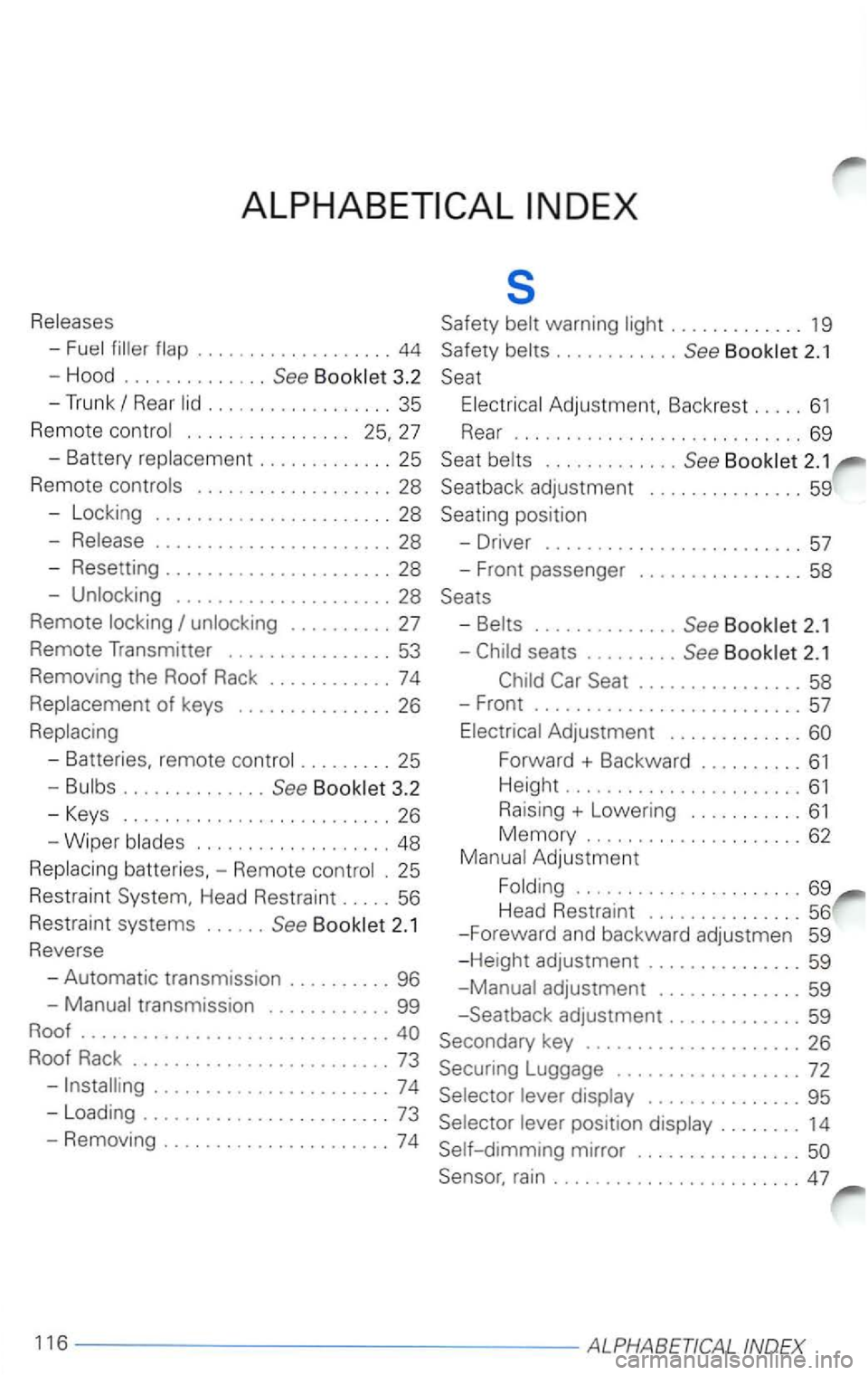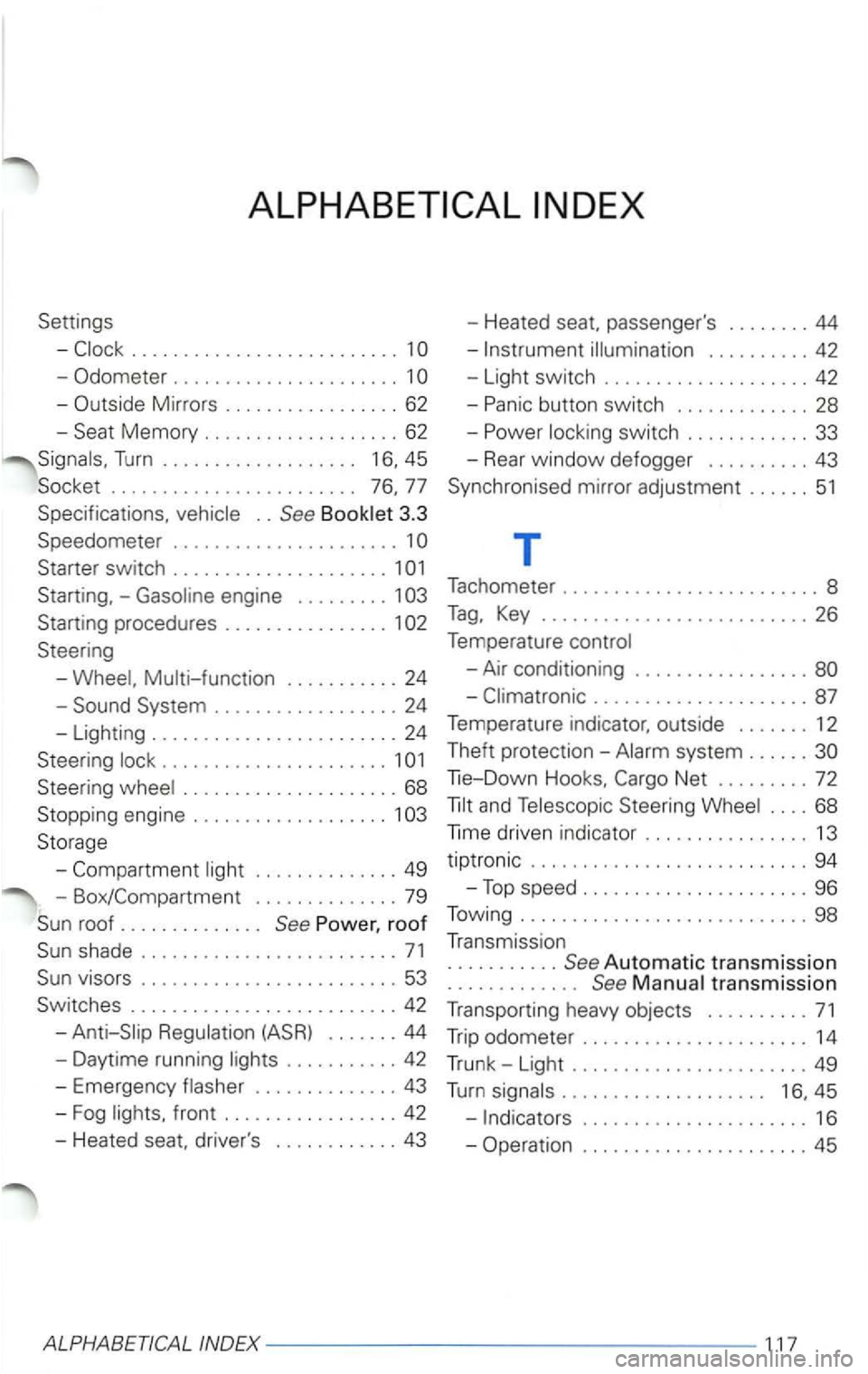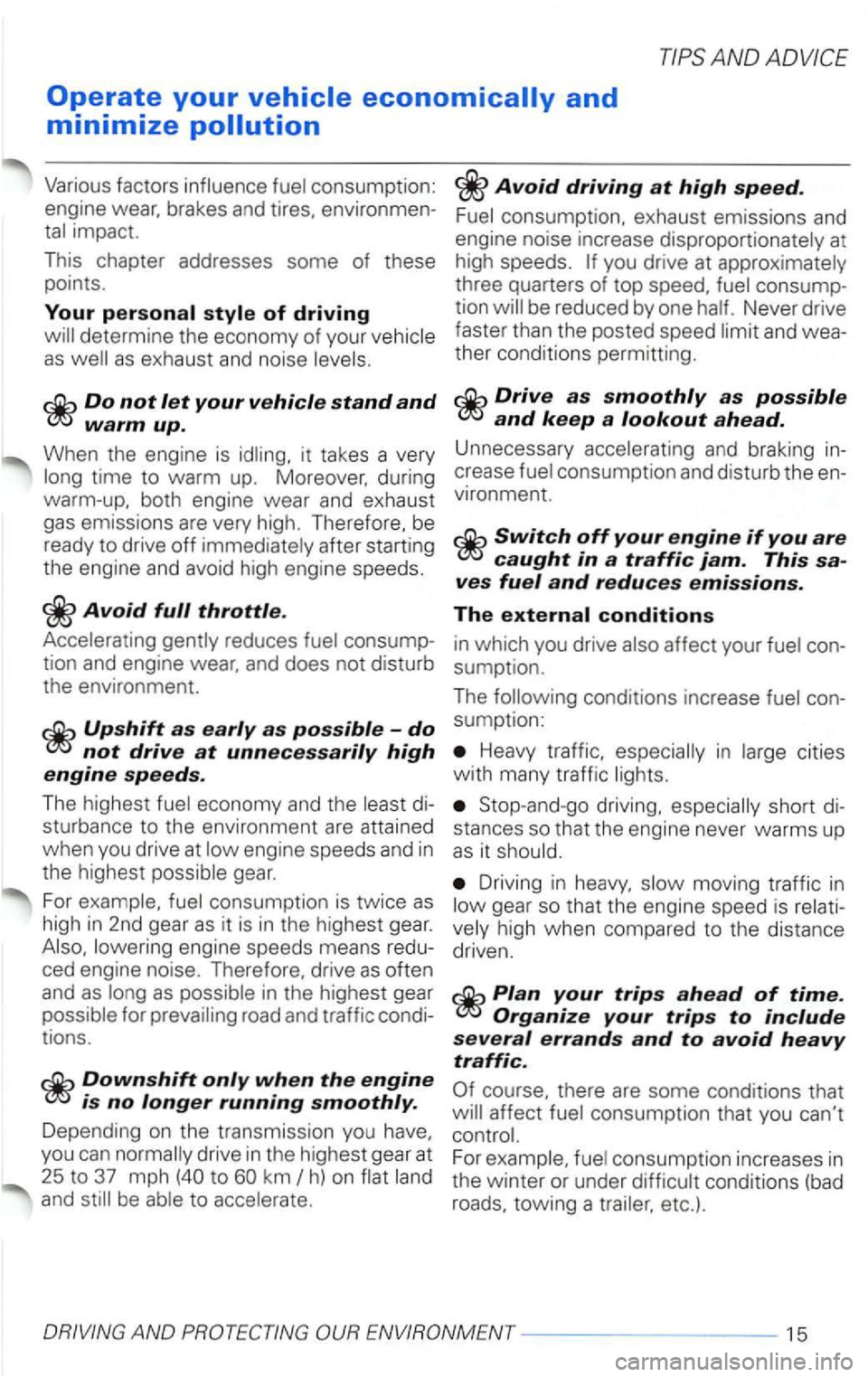Page 272 of 483

A
Adjustable steering column .......... 68 Alternator/Generator
.. .............. 19
Adjusting Anti-lock
braking system (ABS) ...... 17
-controls ............. .. . Anti-Slip regulation (ASRl
- Head Restraints .
............... 56 -
..................
.. See a/so Alarms
Air circulat ion -luggage compartment . 72 Armrest ........................... 66
Air conditioning
....................
cooling ...... ............ 85 -
Storage bin . . . . . . . . . . . . . . . . .
..................... 89 -Tiptronic ....................... 94
Air vents
-Towing ........................ 98
- Air conditioning
................. 82 Auto matic transmission (5-speed) .... 93
-
..................... 91 - Back-up lights .................. 96
Airbag
............ See also Bookl et 2.1 -Igni tion key safety interlock ...... 93
-
safe ty .................... 34 Average driving speed indicator ...... 11
-Indicator light ................... 16 Average fuel consumption indicator ... 11
Airbag indi cator light ................ 16
Alarm system
........ ..............
Page 280 of 483

s
............. 19
................... 44 Safety ............ See
.................. 35 Adjustment , Bac krest .. ... 61
R em ote
. . . . . . . . . . . . . . . .
............. See
. .................. 2 8 Seatback adjustment ............... 59
- Locki ng
....................... 28 Seating position
-
....................... 28 -Dr ive r ......................... 57
-Resetting ...................... 28
-
..................... 28
Remote
.......... 27
Remote Transmitter
................ 53
Remov ing the Roof Rack ............ 74
of keys ............... 26
-Batteries, remote
.............. See
batteries, -Remote . 25
Restraint
Head Restraint ..... 5 6
Restraint systems
...... See 2.1
Reverse
-Automatic transmission .......... 96
-
....................... 74
-Loading ........................ 73
- Removing ...................... 74
-Front passenger ................ 58
-.............. See 2.1
-2.1
Adjustment .............
.. .................... 69
Head Restraint
............... 56
-Foreward and backward adjustmen 59
-
Height adjustment ............... 59
adjustment ........ ...... 59
-Seatba ck adjustment
............. 59
Secondary key .
................. ... 26
Sec uring Luggage
.................. 72
............... 95
........ 14
mirror ................
INDEX
Page 281 of 483

Settings
-Odometer . . . . . . . . . . . . . . . . . . . . . . 1
- O utside Mirrors ......... ...... .. 62
-Memory ............. ...... 62
Turn . . . . . . . . . . . . . . . . . . .
. . . . . . . . . . . . . . . . . . . . . . . . 76. 77
Spec ificat ion s,
3.3
Speedometer . . . . . . . . . . . . . . . . . . . . . . 1
-engine ......... 1
Starting procedures ................ 1
....... ........... 24
- Light
ing ........................ 24
Steer ing
............ .. ........
Steer ing
-. .... ......... 49
-
roof
.......... .... 43
- Fog
switch ............ 33
-
Rear window defogger ......... . 43
Synchronised mirror adjustment .. .... 51
T
Tachometer ......................... 8
Tag, Key .......................... 26
Tem peratur e
-Air conditioning .................
-......... ............ 87
Temperature indi cator , outside
....... 12
The ft protection -
and Steering .... 68
driven indicator ............... . 13
t iptronic .
.............. ....... ..... 94
-
Top speed ........... ........... 96
Towing ..
.......................... 98
Transmis sion
........ ... Automatic tran smission . . . . . . . . . . . . . transmission
Transporting heavy objects .......... 71
Trip odometer . . . . . . . . . . . . . . . . . . . . . . 14
Trun k - Light ....................... 49
Turn . . . . . . . . . . . . . . . . . . . . 45
-
Page 376 of 483

Various factors influence fuel consumption:
engine wear. brakes
and tires, environmen
tal impact.
T his chapter addresses some of these
points.
Your
warm up.
When the engine is idling, it takes a very
long time to warm
up. Moreover. during
warm-up, both engine wear and exhaust
gas emissions are very high. Therefore, be
ready to drive
off immediately after starting
the engine and avoid high engine speeds.
Avoid
Upshift as early as possible -do not drive at unnecessarily high engine speeds.
The highest fuel economy and the least di
sturbance to the environment are attained
when you drive at l
ow engine speeds and in
the highest possible gear.
For example , fuel consumption is twice
as high in 2nd gear as it is in the highest gear.
Downshift only when the engine is no longer running smoothly.
Depending on the transmission you have.
you can normally drive in the highest gear at
25 to 37 mph
(40 to km
Avoid driving at high speed.
Fuel consumption, exhaust emissions and
engine noise increase disproportionately at
high speeds.
you drive at approximately
three quarters of top speed, fuel consump
tion
be reduced by one half. Never drive
faster than the posted speed limit and wea
ther condit ions permitting.
Drive as smoothly as possible and keep a lookout ahead.
Unnecessary accelerating and braking in
crease fuel consumption and disturb the en
vironment.
Switch off your engine if you are caught in a traffic jam. This sa
ves fuel and reduces emissions.
The
Heavy traffic, especially in large cities
w ith many traffic lights.
Stop-and-go driving, especially short di
stances so that the engine never warms up as it should.
Driving in heavy, slow moving traffic in low gear so that the engine speed is relati
vely high when compared to the distance
driven.
Plan your trips ahead of time. Organize your trips to include several errands and to avoid heavy traffic.
course. there are some conditions that affect fuel consumption that you can't
control.
For example, fuel consumption increases in
the wint er or under difficult conditions
(bad roads. towing a trailer. etc.).
DRIVING AND
Page 382 of 483
Trailer towing tips
when to
wing a
weight and weig ht distribution. per
formance and economy depend
on
how your and
operate your rig.
Before you
tow your
you the
unit.
Backing up is
and requires practice.
Steering
wi
thout a
you need
a
than turn ing radius.
When passing, remember that you cannot
be
cause
of the added Make sure you have enough room to pass. After passing. of room for your
changes.
AND
After parking , the and
on a it cannot be avoided. do
so
foot brake .
Have someone chocks under both
With chocks in bra
kes
Turn to curb.
parking brake.
and
transmission in first or reverse gear.
you move the
the
to
move the position.
When restarting after parking on a
the engine.
the parking brake and
and have someone retrieve the
Notes
your may require more frequent maintenance
due to the extra
page 31.
DRIVING AND ENVIRONMENT---------21
Page 390 of 483
Engine compartment
bris from entering the interior
through the heating
and ventil ation ducts
The engine compartment and transmission
have been corrosion protected
at the
mation given on page 22.
Good anti-corrosion treatment is very the
is frequently driven on salted roads. the
entire engine compartment and plenum
or if
you have the engine
the anti
corrosion treatment is almost always
is therefore essential to ask
for a long-last ing corrosion protection of
If you must rinse off gasoline, oil residue or grease while your are cleaning your engine, then the dirty
water should be run through an oil separator filter. We recommend
that you have your engine cleaned at a qualified workshop or service
Page 391 of 483
AND
General notes
We recommend that you have the engi
ne compartment and th e underside of your
Also. whenever the lower body transmission or engi ne assemblies have
be en repaired. any anti-corros io n
coating
lost on the affec ted surfaces shou ld be app lied .
salt spray deposits
and oily subst ances must be removed.
Your authorize d dealer
stocks the cleaning and preservation solu
tions recommended by the factory for this
purpose and has the equi pment necessary
to apply them . Therefore, any additio nal
corrosion protection work shoul d be perfor
med by a
dealer. Using
-----------------CAR E AND CLEANING
Page 392 of 483
Maintenance
Your has been designed to
mum.
However, a certain amount of
By regularly maintaining your vehicle, you help make sure that emission standards are maintained,
thus minimizing adverse effects on the environment.
For
maintenance your Maintenance see Booklet
1.1.
Under difficult operating
when towing a very
some service work be performe
between the specified.
This
th
air
injection and emission r
increasing technr
very strict
the nature of repairs and adjustments to en[ and transmission parts which an owne1 can perform.
Maintenance. adjustments and repairs
require testing
maintenance, adjustments and
repairs can impair the ope ration and
warranty. Therefore, proof of servicing in
accordance with the maintenance
made within the warranty
period .
Above
in doubt about any servicing, have it done by your or any other
workshop.
We urge you to give your
ties. to keep your
Performing
the need arise and trained
of
the the
instructions given.
serve the provided .